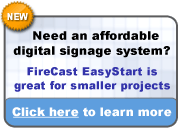I noticed that quite a few news outlets were carrying this article about digital signage, using Target as the latest example of major retailers catching the wave of deploying in-store digital media networks. They note that:
Ok, so a lot of people are curious to see what kind of things Target does with its own network. They have the breadth and depth of skill to pull off an amazing feat with custom-branded in-store content supplemented with digital signage-specific advertising, targeted narrowcasts, local information (presumably customizable down to the store/department level), and of course, media provided by partner firms.Whether suspended from ceilings or posted at check-out lanes, in-store TV is gaining momentum as a growing number of retailers -- from Wal-Mart to Best Buy -- tap into "narrowcasting," closed-circuit-type networks aired across their chains. These networks broadcast a steady stream of commercials that include weekly specials, product releases and, increasingly, image and brand advertising.
But Target's in-store network is noteworthy because it makes the retailer one of the first to operate and own its system rather than farm it out to a media company, said Bill Collins, a principal at WBC Narrowcasting Group, a Cincinnati-based media consulting firm.
By owning its own network, Target has a greater ability to build its brand image and ensure the marketing is consistent with what it is doing in print, billboards and other channels, Collins said.
But the future looks good, as they finish their article with this statement:
So far, in-store TV seems to be paying off for retailers. [Laura] Davis-Taylor said retailers are finding that products advertised on their networks show an average 10 percent to 20 percent increase in sales compared with normal periods and no advertising.
Industry experts said national retailers typically spend millions of dollars to install and run their in-store TV networks.
I don't know if I qualify as an industry expert, but I do know that many of our retail customers do realize these kinds of lift. Still, I don't know how much of it is due to the digital nature of digital signage, and how much is due to the ability to be sure that the signs have launched and are running. POPAI has shown in numerous studies that an 8-12% lift is attainable with regular pop, but the overall gains are limited by the fact that only 25-30% of displays are ever deployed in some cases.

 Subscribe to this blog
Subscribe to this blog Follow Bill Gerba on Twitter
Follow Bill Gerba on Twitter
No comments:
Post a Comment